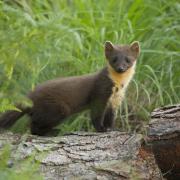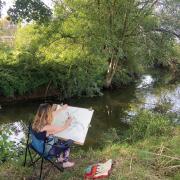In his latest book, John Lewis-Stempel immerses himself in this country’s distinctive habitats, from chalk downland to woodland, and fen to coastal cliffs. In this extract, he sings the praises of ‘The Queen of Trees’, the noble beech

I knew a beech tree once. By which I mean I greeted her every day, a fingertip touch to her cold slate skin, as I climbed over the stile into the Herefordshire wood I managed, where our sheep, cattle and pigs roamed. She was not quite alone; she had sisters near by, a small sorority, yet she was sufficient in herself to create the quintessence of beechwood: the sense of entering a sacred space, that particular austere atmosphere. Winter or summer, to enter a beechwood is to enter a cathedral; the immense grey pillars, the shared mystried gloom, the echoing emptiness. Vita Sackville-West knew this, writing about the beeches at Knole, ‘Your stone-grey columns a cathedral nave/Processional above the earth’s brown glory!’ The other way around, of course, since to enter a cathedral is to enter the vast silence of the beech grove; the Gothic architects of our great houses of prayer were inspired by the stone-toned beech, and its elegant ability to buttress the roof of the heavens, together with its gift to cast an atmosphere of sanctuary. John Evelyn, the Stuart diarist and arguably Britain’s first arboriculturist, noted of Fagus sylvatica in his 1664 Sylva, or a Discourse of Forest-Trees, and the Propagation of Timber in His Majesty’s Dominions (the first book published under the auspices of the newly formed Royal Society), ‘They make spreading trees, and noble shades with their well furnish’d and glistering leaves [. . .] The shade unpropitious to corn and grass, but sweet, and of all the rest, most refreshing to the weary shepherd.’ Evelyn’s ‘noble’ was apt. The beech is ‘the Queen of Trees’, and, in a proper maternal majesty, protective; beech is shade for the weary in summer’s heat, and the blue cowls of leaf shadow make excellent cover against that other inevitable of the British high season: rain. The beech is the umbrella tree, the parasol tree.
Beech has more presence than any other tree, even oak. I learned in those woodland-tending days that oak is the hail-fellow King of the Wood, beech the Ice Queen. Oak is one trope for Britain, hearty, rustic and guileless; the smooth-boled beech is the alternative England, the shadow-self, secret, minimalist, spiritual. Cold. The arrival of the beech here is contentious. Sometimes it is claimed as a Roman import. But beech pollen has been found in Hampshire dating from 6000 bc, some five hundred years before the Channel departed us from mainland Europe. It was here when Britain became an island, even if it was the last of the native trees to colonize the isles after the retreat of the Ice Age. Beech advanced under its own steam up to a line between the Severn Estuary and the Wash, and then halted; it does not set good seed in the cooler north. To this day, the natural parish of beech is southern England, southern Wales; neutral, slightly acidic soil is its preferred habitat, with the free-draining limestone of the Cotswolds, the Downs and the Chilterns particular bastions.
England: A Natural History, by John Lewis Stempel, is published by Doubleday in hardback, priced £25.




























